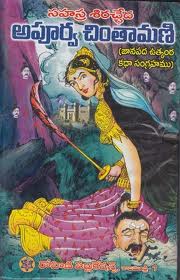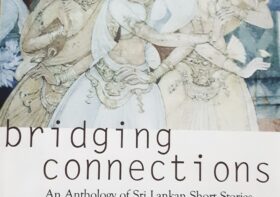The wonderful Chintamani –Be-header of 1000 heads

Article by: Raghavendra Bethamcharla
Sahasra Sirascheda Apoorva Chintamani (సహస్ర శిరచ్ఛేద అపూర్వ చింతామణి), title of this voluminous but un-put-down-able tome, does literally translate into “The wonderful Chintamani –Be-header of 1000 heads”. Promise. Gory? Definitely not, considered a classic literary work, it was a part of countless Telugu children’s bed time story routine . Interesting? You bet. And for me, most interesting aspect of all, was the literary riddle around which the story is woven. More about it later.
Ichchaapurapu Ramachandram garu (ఇచ్చాపురపు రామచంద్రం గారు) is the author of this fantasy, jaanapada (folklore) thriller. That is all I can characterise it as “a fantasy, jaanapada thriller”, more in the Paathalabhairavi and ViThalaachaarya mould, if you know what I mean.
I know for sure that this well worn book is hiding somewhere, in the countless books we have “collected” over years as a family. A legacy of my dad, a writer by pravrutti (ప్రవృత్తి) (hobby) and a lecturer in public administration by vrutti (వృత్తి) (Job). Thanks to him for the darkest galleys of Treasure island, the Jousting grounds of Ivan-hoe, the red hardbound covers of “Sarat saahityam” etc compete equally with the baalamaharshi, chintamaNi, Shobha, Anandu etc of this and other “local” epics. Love you dad.
Introduction
In a nutshell, a Princess is vow bound by her guru that she should marry only that Prince who can answer his 5 questions and behead the one who fails in this attempt. And thus the name “sahasra SrasCheada” – “Be-header of 100 heads”
One of victims (the first if I remember right) is her sweetheart and her first cousin (బావ). Heartbroken but steadfast in her promise, chintamani whiles her time away in the company of her chelikatte (చెలికత్తె)( Maiden) Shobha. Though the title suggests ChintamaNi, as the main character of the story, she is not. She is only the kaaranam (కారణం)(Cause) of the epic journey of another Prince, Anand, documented in this, just like Kaikeyi for RaamaayaNa, very much lost in the story. Shobha, her hand maiden plays an important though small, part, in the story moving forward.
The gem in the story
No, it is not the description of the mountains, of the treacheries, of the devils and demons, the mighty all female kingdom, the sea faring etc that caught my attention and endeared me to this when I was about 10. It was the small riddle, a literary gem, the Guru of chintamaNi poses to her as an answer to her query if the 5 questions she has been asked to ask her suitors, actually have any answers at all. It is this literary gem that stole my heart. Without giving away this gem let me put his answer in my own words…..”if balamaharshi (name of the guru) does penance upside down, chanting the panchaakshari mantra (the 5 lettered mantra)…………….., you will get your answer, DO NOT ASK ME ANYMORE MAIDEN” so saying the guru leaves chintamaNi and Shobha with and without the answer.
The Journey
So begins the journey of Anand to Yaana, Mahaa, Sima, Vaala & Yaaba kingdoms. Didn’t catch it? Go buy and read the epic. Except for the mahaa, I have not heard of these words before then and so was byhearting them riddle-solution given by her guru daily to remember these names “…..if balamaharshi (name of the guru) does penance upside down, chanting the panchaakshari mantra (the 5 lettered mantra)……………..”. Oh, what fun childhood was!
The journey of Anand, come to think of it, is almost like Raama’s own aayana (ఆయన) (movement) i.e like RaamayaNa. Anand does cross a sea, does go through the tunnels of a hill (on the shoulders of a benevolent Rakshasa if I remember rightly again) etc but unlike Rama, he himself faces the ultimate agnipareeksha (అగ్ని పరీక్ష ) (Test by Fire) at the end, as yes, as all heroes, he manages to answer the 5 questions and so must marry chintamaNi…..uh oh, what about his sweetheart, the lovely handmaiden shoBha then? GO READ THE STORY
The Villain & Villains
Oh there are the usual villains, the adulterous queen, the wronged queen, the wicked G….oh, was about to give out the surprise. No, that has to wait till you discover it in the book. GO BUY THE BOOK 
Fiction




Anjani Kumar Punyasri
Sir does any one know where I will get the original version of kasi majili kathalu and apoorva chintamani. I need telugu grandhkam not diluted version.I am ready to buy or pay rent if anyone has please provide if any one has I am searching it for quite a long time
gsrammohan
చిన్నపుడు విపరీతంగా ఆకర్షించిన పుస్తకం. చాలా పెద్దపుస్తకం. సహస్ర శిరఛ్చేద బదులు వేయి శిరస్సులు ఖండించిన అపూర్వ చింతామణి కథలు అని ఉన్నట్టు గుర్తు.
S. Narayanaswamy
ఈ కథని గురించి నా జ్ఞానం చిన్నపిల్లల పాకెట్ పుస్తకం, ఓ బృహద్గ్రంథం, ఇంకా సినిమా .. ఇవన్నీ కలగలిసిపోయిన పులగం. గురువిచ్సిన సమస్య భాకరియహా అని, ఊళ్ళు కరిపురం, రియపురం, యహపురం అనీ గుర్తు. Anyway .. good memories ..
కౌటిల్య
ఈ కథ “పురాణం పిచ్చయ్య శాస్త్రి” గారిది. మొదట 1927 లో ప్రచురితమయ్యింది.ఆ రోజుల్లో వచ్చిన కథాసాహిత్యం, వచనసాహిత్యం చాలా వరకు పురాణం వారి కలం నుంచి వెలువడినవే. వీరి మరో రచన “విచిత్ర కాశీరామేశ్వర మజిలీకథలు”. ఎస్వీగోపాల్ అండ్ కో, సి.వి.కృష్ణా బుక్ డిపో, కాళహస్తి తమ్మారావు అండ్ సన్స్ మొదలైన పబ్లిషర్స్ వీరి రచనలు ప్రచురించేవారు. ముఖ్యంగా మహాభారత, రామాయణ కథలనీ, జనపదంలో అనుశ్రుతంగా వచ్చే కథలనీ చక్కటి వచనంలో అందించేవారు. నలచరిత్రము, పాండవ అజ్ఞాతవాసము,అభిమన్యుని యుద్ధము, విజయాశ్వ చరిత్రము, భట్టివిక్రమాదిత్య కథలు, పతివ్రతల కథలు…ఇలా ఎన్నో వచనరచనలు… [వీరు మధిర సుబ్బన్నదీక్షితుల కాలం వారే. కాని, మధిరవారు రాసినవి “కాశీ మజిలీ కథలు”(1926), మొత్తం 12 భాగాలు]….
తరువాత కొవ్వలి ఇదే కథని కొంచెం మార్చి వ్రాశారు. నవలలో చెప్తారు, పురాణం పిచ్చయ్యగారి రచనకి అనుకరణ అని. పురాణం వారి కథలో మూడు ప్రశ్నలుంటాయి, కొవ్వలి కథలో ఐదు ప్రశ్నలు. సినిమాకి పురాణం వారి కథనే వాడుకున్నారనుకుంటాను.
ఇక ఈ ఇచ్చాపురంగారి సంగతి తెలీదుగాని, రోహిణీ పబ్లిషర్సు వాళ్ళు మాత్రం చక్కగా పాత పుస్తకాలని ఫొటో కాపీలు తీసేసి ప్రచురించేస్తుంటారు. కనీసం ముందు పబ్లిషర్సు పేర్లు కూడా వ్రాయరు. కొన్నిటికైతే, తామే కొత్తగా రాయించి వేస్తున్నట్టు ఎవరో ఒక ఆథర్ పేరు వేసేస్తుంటారు. దానికి ఇలాంటి కాపీరచయితలు ఒప్పుకుంటారు కాబోలు! పాతవాటిని ప్రచురించేప్పుడు, ఆ రచయితల పేరుతోనే ప్రచురిస్తే, ఆ రచనకి ఇంకాస్త విలువ పెరుగుతుందని ఈ కాపీ రచయితలకీ, కాపీ పబ్లిషర్సుకీ ఎప్పటికి తెలిసేనో!
pavan santhosh surampudi
రచయిత చేతిలో కాపీరైట్ ఉంటే ఆయన మరణించిన 60 సంవత్సరాలకు, పబ్లిషర్ వద్ద ఉంటే తొలిగా ప్రచురించిన 65 సంవత్సరాలకు కాపీరైట్ కాల వ్యవధి ముగిసిపోతుందనేది భారత కాపీరైట్ చట్టం చెప్పే విషయం. ఇక దాన్ని ఎవరైనా ముద్రించుకుని అమ్ముకోవడం వంటివి చేయవచ్చు.
ఐతే దానర్థం రచయిత పేరు కూడా మార్చి ముద్రించేసుకొమ్మని కాదు కదా. కాపీరైట్ ఫ్రీ అంటే అర్థం ఆ రచయిత పట్ల కనీస గౌరవాన్ని కూడా వదిలిపెట్టమని కాదు. ఇది నైతికంగా తప్పు మాత్రమే కాదు బహుశా రచయిత పేరుని మార్చి ప్రచురించడం చట్ట వ్యతిరేకం కూడా కావచ్చు.
ఏల్చూరి మురళీధరరావు
కౌటిల్య గారు, _/\_ !
పురాణం పిచ్చయ్య కవిగారి కాలం 1871 – 1951. నెల్లూరు వాసి. చేసిన రచనలలో అధికభాగం యక్షగాన నాటకాలు, పద్యకావ్యాలే. వారి ‘విజయాశ్వ చరిత్రము’ వచనకృతి కాదు. చిత్రకవిత్వానికి పేరుపడిన అతిప్రౌఢమైన పద్యకావ్యం. అందులోని పద్యాలలో ఒకటి:
నారాయణ! దేవేశా!
శౌరీ! మురముఖ్యరాక్షసక్షయ! సకలా
ధారా! వరద! యజరా! శృం
గారాంగా! శుభనివేశ! నాగారాధ్యా!
గ్రాంథికరచనలలో వారి పేరు పిచ్చయ్యశాస్త్రి గారు అని లేదు. పిచ్చయ్య కవి అనే ఉన్నది. ‘పాండవ అజ్ఞాతవాసము’ అని వారి రచన వేరొకటి ప్రకటితమైనదేమో నాకు తెలియదు కాని, 1934లో వారి వచన రచన ‘పంచ పాండవుల వనవాసము’ గ్రాంథికభాషలో వెలువడినది నా దగ్గరుంది. తక్కినవాటిని నేను చూడలేదు. దగ్గరే కనుక మద్రాసు పబ్లిషర్సుకు రాసిపెట్టేవారేమో.
మదిర సుబ్బన్న దీక్షితులు గారు 1868లో జన్మించారు. శ్రీపాద కృష్ణమూర్తిశాస్త్రి గారికి సహాధ్యాయి. వారి ‘కాశీ మజిలీ కథలు’ 1898లో మొదటిసారి వెలువడింది. అది కథాసరిత్సాగరము ఆధారితంగా రచితమని వారే చెప్పుకొన్నారు. 1926 లోనిది పునర్ముద్రణమేమో. అందులోని ఆరవ భాగమైన ‘శంకరాచార్య చరిత్రము’ విద్యారణ్య మాధవాచార్యుల వారి ‘శంకర దిగ్విజయ’ కావ్యానికి సలక్షణమైన వచనానువాదం. దానినే సంస్కరించి వారు 1908లో పరివర్ధిత ముద్రణను ప్రకటించారు. ‘సహస్ర శిరశ్ఛేద అపూర్వచింతామణి’ కూడా ‘కాశీ మజిలీ కథలు’ లోనిదే.
మొదట ‘సహస్ర శిరశ్ఛేద అపూర్వచింతామణి’ అనే తొలిముద్రణలలో సరిగానే అచ్చయి ఉండేది. ‘శిరచ్ఛేద’ అని ఎప్పుడు మారిందో!
Raghavendra Bethamcharla
లేదండి.
ఇది, నాకు తెలిసినంతవరకూ కాసీ మజిలీ కథల్లోనిది కాదు.
అసలు ఇది కథే కాదు. మేము చదివిన వర్షన్ అయితే 500-600 పేజీల నవల అనే చెప్పాలి. ఇచ్చాపురపు రామచంద్రం గారు అదీ ఇదీ రెండూ రచించారేమో. ఇంకా బాగా తెలిసిన వారు చెప్పాలి.
Halley
నేను ఏదో ఈ వికీ లింకుని ప్రమాణంగా తీసుకొని అడుగుతున్నాను లెండి . అది వికీ కాబట్టి నిజమని అనుకోనక్కర్లేదు
http://te.wikipedia.org/wiki/%E0%B0%B8%E0%B0%B9%E0%B0%B8%E0%B1%8D%E0%B0%B0_%E0%B0%B6%E0%B0%BF%E0%B0%B0%E0%B0%9A%E0%B1%8D%E0%B0%9B%E0%B1%87%E0%B0%A6_%E0%B0%85%E0%B0%AA%E0%B1%82%E0%B0%B0%E0%B1%8D%E0%B0%B5_%E0%B0%9A%E0%B0%BF%E0%B0%82%E0%B0%A4%E0%B0%BE%E0%B0%AE%E0%B0%A3%E0%B0%BF
Sreenivas Paruchuri
As Raghavendra gaaru said the above book is not from (/based on) ‘కాశీ మజిలీ కథలు’. The “author” in Telugu was given a Tamil book of same name and asked to re-tell it in Telugu by the publisher: Mudaliyar. See Mudaliyar’s and Puranam Picchayya’s notes (/prefaces). And, indeed, Sri PP took his liberties and created a great fiction work of his own, like kovvali in mid-1950s (BTW Kovvali’s 1955 book should be in DLI.) Incidentally I know a couple of scholars who have great interest in this magnificent book and would like to do a comparative study of Tamil and Telugu works.
Now is it a “Tamil” story? Or questions on the “origins” of such stories is IMO out of place, out of context and do not do any justice to the creative genius of the story-tellers.
Regards, Sreenivas
Halley
ఈ కథ కాశీ మజిలీ కథల లోనిదా ? Then shouldn’t the author also be మధిర సుబ్బన్న దీక్షితులు? ఈ పరిచయం ప్రకారం ఇచ్చాపురపు రామచంద్రం గారు వాడుక భాషలోకి పరివర్తన చేసారు . http://www.avkf.org/BookLink/images14000/14398_desc.gif